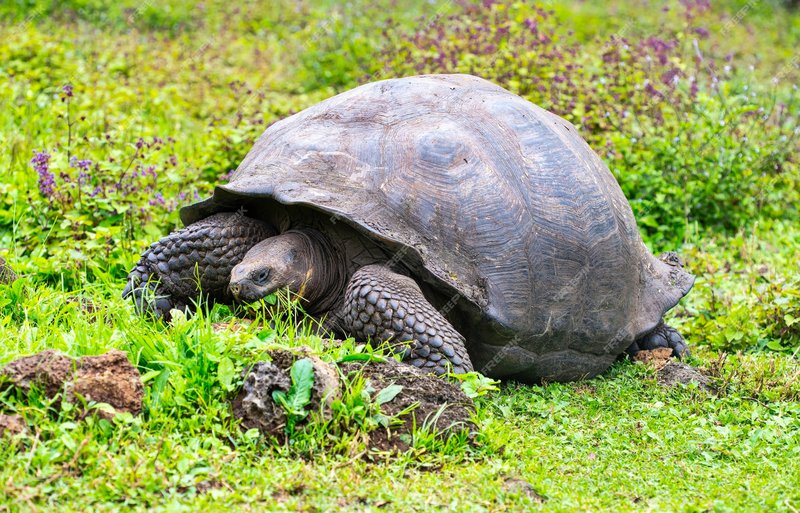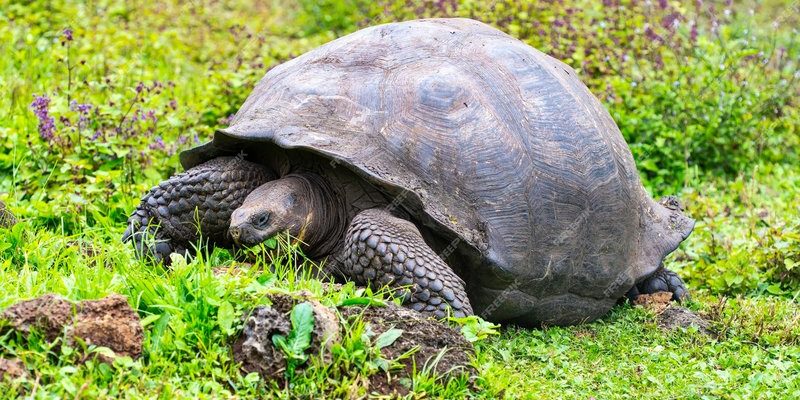
Some creatures mimic the tortoise’s slow-paced lifestyle, while others echo their physical traits or habitats. Imagine sipping coffee while discussing the wonders of biodiversity. Here’s the thing: uncovering these connections not only sparks curiosity but also deepens our appreciation for the variety of life on our planet. So, let’s dive into this fascinating world and explore 10 animals that are similar to the Galápagos tortoise and how you can tell them apart.
1. Aldabra Giant Tortoise
The Aldabra giant tortoise is like the Galápagos tortoise’s cousin. Both species are impressive, weighing several hundred pounds and living for many decades—sometimes even over a century! Found on Aldabra Atoll in the Seychelles, these tortoises share many similarities in appearance and behavior. They have a domed shell and thick legs, which help support their hefty bodies as they roam.
One of the main differences between the Galápagos and Aldabra tortoises is their shell shapes. While the Galápagos tortoise has a more saddle-shaped shell, the Aldabra tortoise’s shell is usually more dome-like. Their habitats differ too; while the Galápagos tortoise thrives in a diverse range of environments, the Aldabra tortoise is mostly found in dry grasslands and scrub forests.
2. Greek Tortoise
If you take a closer look at the Greek tortoise, you’ll notice some striking similarities to the Galápagos tortoise, especially in size and slow demeanor. Native to southeastern Europe, this tortoise is smaller, typically reaching lengths of about 8-12 inches. They have a high dome shape and visibly patterned shells that can range from yellow to olive green.
Now, how do you tell them apart? While the Greek tortoise has prominent yellow or cream markings on its shell, the Galápagos tortoise often has a less detailed pattern, usually blending shades of brown and gray. Moreover, the Greek tortoise prefers a Mediterranean climate, unlike the arid surroundings of the Galápagos.
3. Sulcata Tortoise
Meet the Sulcata tortoise, another fascinating relative often compared to the Galápagos tortoise. Originating from the African savannah, this tortoise is the third-largest in the world, just like the Galápagos. It has a similar herbivorous diet, munching on grasses and leafy weeds.
However, a key distinction lies in their habitats. The Sulcata prefers hot, dry grasslands, while the Galápagos tortoise inhabits islands with varied climates. Additionally, the Sulcata’s shell is more pointed and has a distinct sculpted appearance, contrasting with the smooth, rounded shell of its Galápagos counterpart.
4. Desert Tortoise
The desert tortoise is a fascinating example of adaptation to arid environments. Native to the southwestern United States, these tortoises are smaller and typically weigh less than the Galápagos tortoise. They can retreat into their shells, using their armor as protection from predators, much like the Galápagos tortoise does.
The real difference? The desert tortoise has a flatter shell and is well-adapted for digging burrows, which helps them escape the extreme desert heat. Their color is generally a lighter brown or tan, which helps reflect sunlight, whereas the Galápagos tortoise has darker shades that absorb heat.
5. Red-footed Tortoise
The red-footed tortoise is hard to miss with its striking red or orange markings on its legs and head! Native to South America and parts of the Caribbean, this tortoise has a smaller and more compact physique compared to the Galápagos tortoise.
While both are herbivores, the red-footed tortoise has a diet that includes fruits, which the Galápagos tortoise isn’t quite as fond of. Shell shape can help you identify them too; the red-footed tortoise generally has a smoother, more oval-shaped shell compared to the Galápagos tortoise’s saddle shape.
6. Burmese Star Tortoise
The Burmese star tortoise is not only smaller but also boasts a unique, star-patterned shell that makes it look like it stepped straight out of a fairytale. These tortoises are native to Myanmar and are known for their striking appearance.
Although they share the same herbivorous diet, the Burmese star tortoise has a more delicate shell compared to the robust Galápagos tortoise. It also prefers a tropical climate, which showcases its adaptability to different environments. Its distinct markings make it easy to differentiate, while the Galápagos tortoise’s markings are much less pronounced.
7. Indian Star Tortoise
Similar to its Burmese counterpart, the Indian star tortoise captures attention through its beautiful shell design featuring star-like patterns. Native to India and Sri Lanka, this tortoise is smaller and has a more pronounced star pattern compared to the Galápagos tortoise.
In terms of size, the Indian star tortoise reaches about 6-12 inches, making it significantly smaller. It also thrives in tropical climates, which means its habitat needs differ from the varied environments of the Galápagos. The Indian star tortoise prefers relatively humid areas, whereas the Galápagos tortoise can often be found in dryer locales.
8. Spotted Tortoise
The spotted tortoise is a smaller species that hails from the southeastern United States. It’s charmingly named for the yellow spots that adorn its black shell, making it visually different from the Galápagos tortoise, which has a more subdued color palette.
You might notice that the spotted tortoise is often not as large or imposing as the Galápagos tortoise, reaching a maximum size of only about 6-8 inches. Their habitat is typically woodlands and grassy areas, showcasing another vital difference in environmental preferences.
9. Leopard Tortoise
Meet the leopard tortoise, known for its striking, leopard-like pattern on its shell. Native to Africa, this tortoise is one of the largest in the world, with its size somewhat comparable to the Galápagos tortoise.
The key differences? The leopard tortoise has a more domed shell and tends to have a more vibrant pattern, resembling its namesake. Additionally, this species prefers more humid savannah-like habitats rather than the rocky islands of the Galápagos.
10. Gopher Tortoise
The gopher tortoise is a terrestrial tortoise native to the southeastern United States, famous for its burrowing habits. Unlike the Galápagos tortoise, which tends to roam in open areas, the gopher tortoise creates extensive underground burrows that provide shelter from predators and harsh weather.
While they both have a similar herbivorous diet, the gopher tortoise is shaped differently, with a more flattened shell and smaller legs. Their habitat choice and social behavior set them apart, as gopher tortoises often share their burrows with other species, a behavior not commonly seen in the Galápagos tortoise.
In conclusion, the Galápagos tortoise stands unique but is part of a much larger family of tortoises and turtles that share similar traits. By understanding these parallels, not only do we enrich our knowledge of these majestic creatures, but we also get a glimpse into the incredible diversity of life on our planet. Whether it’s the stunning designs or their shared habitats, each species has its unique story, just waiting to be discovered.

